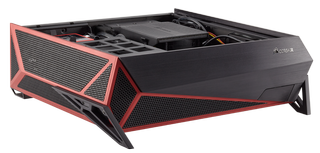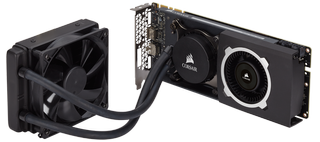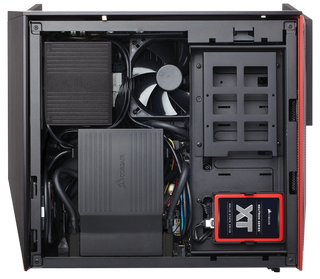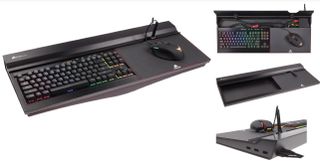Corsair’s Bulldog DIY living room PC aims for 4K TV gaming

When Valve’s hardware partners launch their Steam Machines later this year, they’re going to have some unexpected competition: a beefy, receiver-sized living room PC from Corsair. They’re calling it the Bulldog, and the name’s apt given its wide, squat chassis. This is not a tiny system like the Alienware Alpha, but a full PC packed into a box that’s still considerably compact compared to a mid-tower case. And Corsair isn’t touting the Bulldog as a cheap entry-level gaming PC to compete with consoles. They see it as a solution for 4K gaming in the living room, as 4K TVs start to supplant 1080p sets. But here’s the cool part: the Bulldog is (almost) completely customizable.
It's not locked to an OS, so you can run Windows or SteamOS or some other flavor of Linux. It really is just a PC, and you'll need to supply most of the components yourself.
Corsair isn’t selling the Bulldog as a complete rig, but as more of a PC building starter kit. For $400, you’ll get the Bulldog chassis, a mini-ITX motherboard, a 600 watt power supply, and a built-in liquid CPU cooler. The rest is up to you: you could run the system off 4 gigs of cheap RAM, an AMD APU, and a single SSD for a couple hundred bucks. Or you could go all out: the power supply can support a $1000 GTX Titan X, Intel Core i7 CPU, and there’s space for three 2.5-inch drives (SSDs and notebook HDDs) or a single 3.5-inch HDD and a 2.5-inch drive.

If you want to get even fancier, Corsair’s also going to sell a $100 GPU liquid cooling DIY kit, which will support current Nvidia and AMD GPUs. By the time Bulldog launches towards the end of the year, Corsair plans to have some pre-outfitted liquid cooled GPUs available from partners like MSI. The liquid cooling offers more overclocking headroom, but the bigger advantage is volume: the fan won’t have to spin up like crazy to keep the card nice and cool.
The Bulldog is the slickest living room PC I’ve seen that supports a full-length graphics card, and it’s clear Corsair put a lot of work into designing the interior.
“The liquid CPU cooler I’m really proud of,” Corsair product manager Dustin Sklavos told me. “Instead of having a conventional CPU liquid cooler where you have the water block and the tubing that goes into a 120mm radiator that mounts to the back of the case, we have a smaller radiator and blower fan and housing, which essentially sucks up ambient heat from within the case. All that air goes through the blower fan and housing and out the back of the case. We’ve essentially created a small form-factor system liquid cooling solution, and it’s capable of cooling about 150 watts, which is definitely more than you’ll ever need in a mini-ITX form factor. That’s allowed us to overclock this system without increasing the noise profile.”

I got to hear the Bulldog running full-tilt with a Core i7 CPU and a Titan X, and it was audible, but quiet for a high-end gaming PC. Placed in an entertainment center, I doubt I’d be able to hear it at all. I did ask Corsair about the possibility of the Bulldog overheating if it was closed into an entertainment center with little ventilation, since that’s been a problem for the last couple generations of game consoles.
The biggest gaming news, reviews and hardware deals
Keep up to date with the most important stories and the best deals, as picked by the PC Gamer team.
“It is a computer, so you can’t necessarily put it in a computer coffin in an entertainment center, but if you just put it on a shelf, where the front at least is open, or there’s a decent amount of space on the back or the sides, it should be fine,” said Sklavos.
Corsair plans to launch the Bulldog in Q4 of this year, with the mini-ITX motherboard running on Intel’s latest platform. That means it should support DDR4 and the latest CPUs. And, of course, if you want to switch out the motherboard down the road, you’ll have that option.
Corsair’s also going to be launching an accessory for the Bulldog, called the Lapdog, following in the same quarter. The Lapdog is a wired lapboard for living room gaming, with a spacious pad for a wired mouse. Interestingly, the Lapdog is mostly just a shell, as it has an empty housing that can fit a mechanical Corsair keyboard (tenkeyless) and a large cable management area for keeping cords out of sight.

I played a few minutes of The Witcher 3 with the Lapdog, and it worked fairly comfortably. It’s definitely big, easily fitting over both of my legs. It looks bulky at first, but once I had it in position it felt nice and stable. It’s well-padded with curved foam to contour to your lap, and I don’t think it would be uncomfortable after an hour or two of gaming. The mousing area is spacious, though I did find myself wanting a bit more vertical room. It’s a far, far sturdier and more practical solution than Razer’s Turret. I don't think you'll want to play competitive GS:GO with the Lapdog, but for most PC games, it should be a viable way to bring the keyboard and mouse into the living room.
The Lapdog is going to cost about $90, or $200 bundled with a mechanical keyboard. The base price feels especially steep for a plastic housing with a couple USB ports. If the wireless Roccat Sova comes out this year as well, it’ll be interesting to see how the prices line up.

Wes has been covering games and hardware for more than 10 years, first at tech sites like The Wirecutter and Tested before joining the PC Gamer team in 2014. Wes plays a little bit of everything, but he'll always jump at the chance to cover emulation and Japanese games.
When he's not obsessively optimizing and re-optimizing a tangle of conveyor belts in Satisfactory (it's really becoming a problem), he's probably playing a 20-year-old Final Fantasy or some opaque ASCII roguelike. With a focus on writing and editing features, he seeks out personal stories and in-depth histories from the corners of PC gaming and its niche communities. 50% pizza by volume (deep dish, to be specific).
Most Popular

